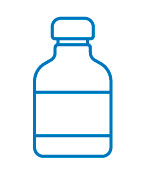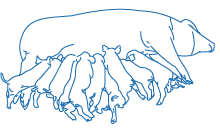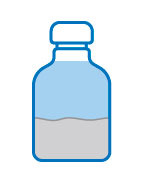PRRS is a viral infection affecting swine. It is widespread globally and has a very high economic impact.
As its name suggests, the virus causes reproductive problems and affects the respiratory system. It is caused by an arterivirus.

The virus is classified into two types: European (genotype 1) and North American (genotype 2).
The summary of the different vaccine characteristics explained below refers to vaccines licensed in the European Union, where vaccines against genotype 1 and genotype 2 are available. However, vaccines against genotype 2 are not approved in all countries.
Type |
|
 |
Most vaccines are live attenuated vaccines but there are also commercial options with the inactivated virus. Live attenuated vaccines against PRRS virus genotype 1 are approved in all countries, but only some have approved attenuated vaccines for genotype 2. Other countries do not authorize the attenuated vaccine against genotype 2 but do authorize the inactivated vaccine. In some countries, there is an inactivated vaccine with both genotypes in the same presentation. |
Intended species |
|
 |
Inactivated vaccines are only licensed for sows and gilts. Attenuated vaccines have a variety of licenses. There are vaccines with a generic license for swine that can be used in breeding females as well as in piglets and pigs. Others are only approved for piglets, finishing pigs, or only for breeding females. |
Indications for use |
|
 |
The indications for use will depend on whether it is a live attenuated or inactivated vaccine and whether it is intended for piglets, breeding females, or both. In general, regardless of whether it is intended for breeding females or piglets, the indications for use of attenuated vaccines refer to reducing viremia. Specifically, when referring to breeding females, the indications include wording such as: “to reduce reproductive disorders, incidence and duration of viremia, transplacental virus transmission, viral load in tissues, and clinical signs in offspring associated with infection with PRRS virus strains”. When referring to piglets or finishing pigs, the specific indications include wording such as: “For finishing pigs, the effect of the virus on the respiratory system is most relevant. "A significant improvement of rearing results (reduced morbidity due to PRRS infection, and a better daily growth and feed conversion) until the end of the fattening period was observed in vaccinated pigs during field trials, particularly in piglets vaccinated at 6 weeks of age.” or "to reduce viremia and nasal shedding caused by infection with European strains of PRRS virus (genotype 1).” It should be noted that when referring to the vaccination of piglets, the indications for the age of vaccination in the technical data sheet are not the same for all vaccines, since some commercial vaccines are registered for use from the first day of life, while others are registered for use from 17 days or 4 weeks of age. The indications for use of inactivated vaccines are restricted to use in breeding females “reduction of reproductive disorders caused by PRRS virus (European strain) in a contaminated environment. Vaccination reduces the number of early farrowings and the number of still-births.” |
Onset and duration of immunity |
|
 |
With attenuated vaccines, immunity is established in piglets or fattening pigs at 2, 3, or 4 weeks, and immunity lasts between 24 and 26 weeks. For sows, immunity is established at 28-30 days and lasts 16-17 weeks. Inactivated vaccines do not specify the onset or duration of immunity.  |
Route of administration |
|
 |
PRRS vaccines should be administered intramuscularly, but some commercial options have the option of intradermal administration, and one vaccine is even registered for intranasal administration. |
Dosage |
|
 |
In the case of attenuated vaccines, piglets are vaccinated with a single dose at the age described in the indications for use and, for breeding females, before introducing gilts into the farm, during each gestation, or every 3-4 months. In the case of inactivated vaccines, vaccination and revaccination are required, primovaccination and then every 3 or 4 months, or at 60-70 days of gestation, depending on the vaccine. |
Combined vaccines |
|
 |
There are no presentations combined with other microbial agents but there is the option of administering together with other vaccines. For piglets, simultaneous administration is allowed after mixing with vaccine against Mycoplasma hyopneumoniae and PCV2 or with simultaneous vaccination, but at different administration sites, against Mycoplasma hyopneumoniae, PCV2, or with the mixture of PCV2 and Lawsonia intracellularis. In breeding females, it can be mixed with porcine parvovirus vaccine or porcine parvovirus and erysipelas. |
Contraindications, special precautions |
|
 |
Since the vaccine contains a live attenuated virus with the potential to be shed by the animals after vaccination and the virus can recombine, it is very important to pay attention to the different warnings and precautions within the technical data sheets which, in summary, include warnings regarding its use in boars that produce semen for negative farms, precautions to avoid the spread of the vaccine virus from vaccinated animals to unvaccinated animals that are to be kept free of PRRS, and avoid vaccinating with different attenuated vaccines on the same farm at the same time or allow a transition period if changing attenuated vaccines. |
333 Staff



